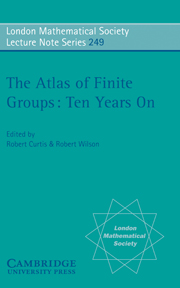Book contents
- Frontmatter
- Contents
- Introduction
- Addresses of registered participants
- Addresses of non-participating authors
- Programme of lectures
- Conference photograph and key
- Symmetric presentations and orthogonal groups
- A constructive recognition algorithm for the special linear group
- Relations in M666
- A survey of symmetric generation of sporadic simple groups
- Harish-Chandra theory, q-Schur algebras, and decomposition matrices for finite classical groups
- The Meataxe as a tool in computational group theory
- Branching rules for modular projective representations of the symmetric groups
- Characters and surfaces: a survey
- On the characterization of finite groups by characters
- Finite linear groups of small degree
- Minimal parabolic systems for the symmetric and alternating groups
- Probabilistic methods in the generation of finite simple groups
- Condensing tensor product modules
- Intersections of Sylow subgroups in finite groups
- Anatomy of the Monster: I
- An integral ‘Meat-axe’
- Finite rational matrix groups: a survey
- Chamber graphs of sporadic group geometries
- An Atlas of sporadic group representations
- Presentations of reductive Fischer groups
- A brief history of the ATLAS
Finite rational matrix groups: a survey
Published online by Cambridge University Press: 19 May 2010
- Frontmatter
- Contents
- Introduction
- Addresses of registered participants
- Addresses of non-participating authors
- Programme of lectures
- Conference photograph and key
- Symmetric presentations and orthogonal groups
- A constructive recognition algorithm for the special linear group
- Relations in M666
- A survey of symmetric generation of sporadic simple groups
- Harish-Chandra theory, q-Schur algebras, and decomposition matrices for finite classical groups
- The Meataxe as a tool in computational group theory
- Branching rules for modular projective representations of the symmetric groups
- Characters and surfaces: a survey
- On the characterization of finite groups by characters
- Finite linear groups of small degree
- Minimal parabolic systems for the symmetric and alternating groups
- Probabilistic methods in the generation of finite simple groups
- Condensing tensor product modules
- Intersections of Sylow subgroups in finite groups
- Anatomy of the Monster: I
- An integral ‘Meat-axe’
- Finite rational matrix groups: a survey
- Chamber graphs of sporadic group geometries
- An Atlas of sporadic group representations
- Presentations of reductive Fischer groups
- A brief history of the ATLAS
Summary
Abstract
The interplay between finite rational matrix groups and integral lattices in Euclidean space is explained, in particular applications of the theory of finite rational matrix groups to the construction of modular lattices are discussed. The finite rational matrix groups of a given dimension are interrelated by the way they intersect and classification results up to dimension 31 are briefly surveyed.
Introduction
The investigation of finite rational matrix groups is an old topic of group theory. However, with the classification of finite simple groups on the theoretical side, and the advance of algorithmic and computational methods on the practical side, a fresh look at the subject might reveal new insights, as suggested in [20]. This has meanwhile resulted in a full classification of the maximal finite rational matrix groups up to degree 31 in [20], [17], [14], [15], [16], as well as the investigation of certain infinite series of maximal finite rational matrix groups.
As one might expect, cf. [20] Proposition (II.6), the reducible groups are not so interesting in the investigations. In this paper, therefore, I shall only deal with rational irreducible maximal finite groups, henceforth abbreviated r.i.m.f. groups. From the point of view of simply enumerating these groups, only the primitive ones play a role, i.e. those whose natural representation is not induced up (over the rationals) from a proper subgroup, cf. [20] Proposition (II.7). However, from the point of view of interrelating the r.i.m.f. groups of a given degree, the imprimitive ones are also relevant, as will become clear in section 3.
There are essentially two different sorts of problems that arise:
Classify the r.i.m.f. groups in a given dimension.
Information
- Type
- Chapter
- Information
- The Atlas of Finite Groups - Ten Years On , pp. 229 - 248Publisher: Cambridge University PressPrint publication year: 1998
